Nearly 40% of Remote Employees Have Made It Look Like They Were Working When They Weren’t, While Almost 1 in 5 Work Fewer Hours Than Expected
The way we work has significantly shifted — and a home office is now the default for many Americans.
Despite return-to-office policies from many employers, remote work has become more common and more permanent for some. As a result, the benefits and drawbacks are coming into sharper focus.
A LendingTree survey of 2,000 Americans — including over 450 remote workers — explores the realities of working from home, from productivity hacks to daily challenges, side gigs and work-life dynamics.
One revealing finding: 51% of remote workers earn additional income while working their primary job. Here’s a closer look at what the data says about how remote work is working.
Key findings
- Most remote workers aren’t strangers to challenges of all varieties. 78% of remote workers face obstacles, such as home distractions (32%), social isolation (31%) and technology issues (29%). Additionally, 47% fear that remote employees would be the first to go if their company were to undergo layoffs.
- Some would argue they’re working (remotely) smarter, not harder, but those tactics can be questionable. 39% of remote workers have used software or hacks to make it look like they’re working when they’re not. Over half (51%) have generated additional income while working their primary job. Among those who haven’t, 58% have considered getting a secondary job while working their primary one.
- Home distractions are prevalent among working parents with young children. Many remote workers with young kids care for them simultaneously, with 39% always doing so and 34% sometimes doing so. Among all remote workers, 69% admit to doing household chores during the workday. However, 52% work more hours than expected, while 18% work fewer.
- Remote work can be a game-changer in the daily lives of some with this opportunity. 70% of remote workers get more sleep, 66% feel more productive and 90% cite an improved work-life balance. Additionally, 91% say their manager trusts them to be productive when working remotely.
- Many of these remote workers hope to never return to an office. 45% of remote workers are opposed to returning to the office full time, and 42% have relocated after getting a remote-friendly job. Additionally, 89% have saved money working remotely, mostly on transportation (72%), food (55%) and clothes (46%).
To understand how Americans view remote work, it’s helpful to know what they want. According to our survey of 2,000 Americans, 56% say their desired work situation includes at least some remote component. Specifically, 36% say a fully remote setup is ideal, while 20% prefer a hybrid arrangement.
Yet, many aren’t working in their preferred setting. Just 11% currently work fully remote, and another 11% are hybrid — figures that fall short of those who desire such flexibility. Our survey focuses on insights from both groups combined since hybrid workers spend at least part of their time working remotely.
Top obstacles for remote workers: Distractions, isolation, tech
Despite enjoying what many consider to be an ideal job situation, most remote workers (78%) report facing challenges related to their work-from-home status.
The top hurdle remote workers navigate is home distractions, followed by social isolation and technology issues. Men who work remotely are more likely to say they face these and other obstacles than women — 81% versus 74%.
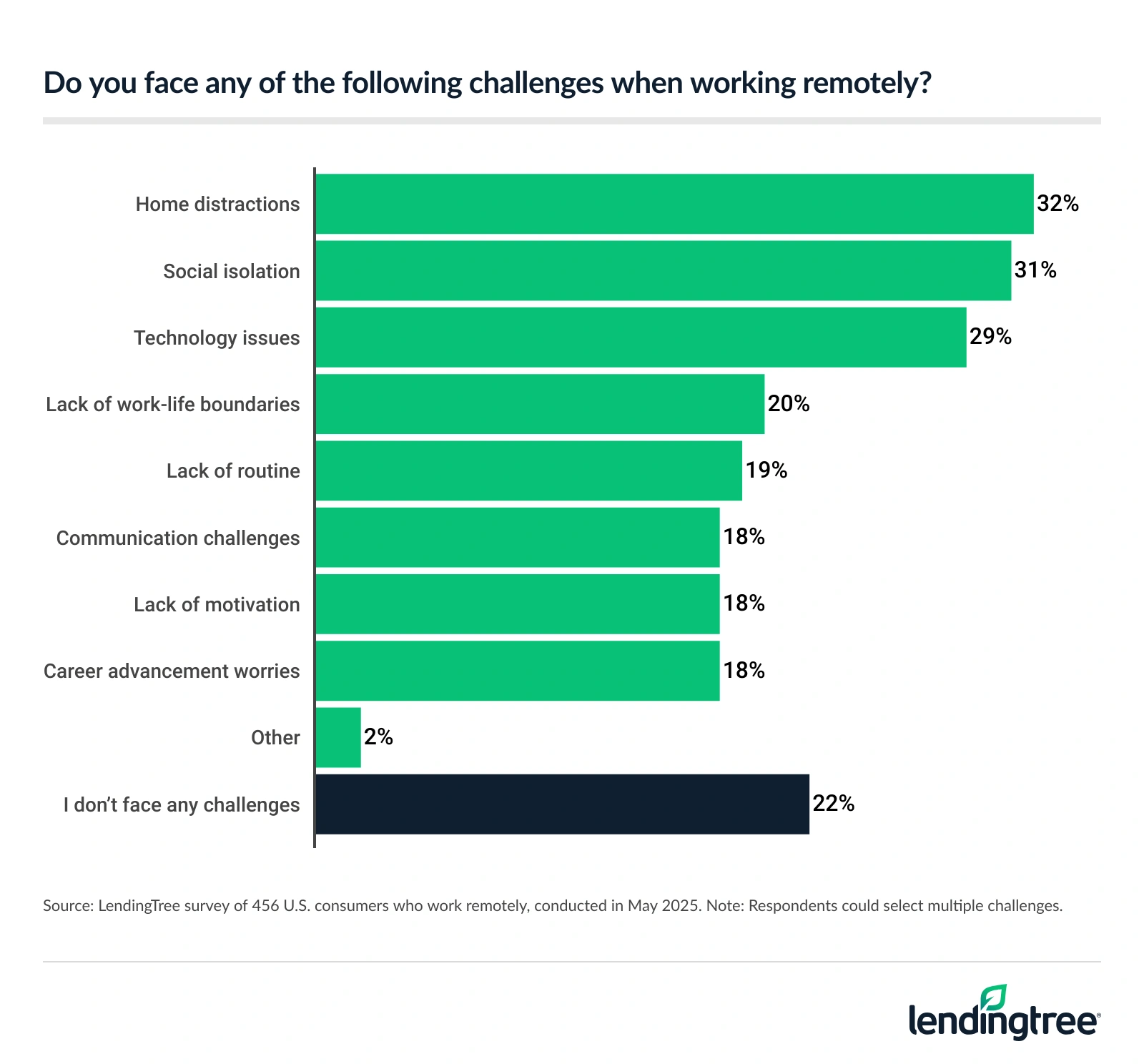
In addition to navigating day-to-day challenges, many remote workers worry their work-from-home status makes them more susceptible to company layoffs than their office counterparts. In fact, 47% fear remote employees would be the first to go if their employer laid off staff. By gender, 50% of men who work remotely share this concern, compared with 42% of women who work remotely. Many remote workers (40%) also feel judged for working from home.
Research shows these concerns may be warranted. A 2023 Live Data Technologies Inc. study revealed that fully remote workers were 35% more likely to be laid off than in-office employees. In 2024, when online home goods retailer Wayfair announced layoffs, the company informed staff that remote employees would likely be the first to be affected.
According to reporting from the Society for Human Resource Management (SHRM), the “out of sight, out of mind” maxim is often in play in today’s landscape of mixed work situations. Remote workers aren’t around to bump elbows in the elevator, pass by in the hallway or collaborate spontaneously. As a result, they can sometimes be viewed as a set of data rather than people. The perception that in-person workers are more productive remains prevalent among some employers. The Live Data Technologies study showed that fully remote workers were 31% less likely to receive promotions than their in-office co-workers.
Some remote workers have used software/hacks to look busy
Perhaps to counter the perception of being less productive, a notable amount of remote workers (39%) have used software or hacks to make it look like they’re working when they aren’t. A higher rate of men report using these tactics than women — 44% versus 32%.
LendingTree chief consumer finance analyst Matt Schulz warns against using productivity software or hacks. “That’s such a risky thing to do,” he says. “If your employer discovers you’re doing that, it’ll likely be seen as a major breach of trust and could have serious consequences. Once you’re seen as dishonest, it can be almost impossible to recover.”
Once you’re seen as dishonest, it can be almost impossible to recover.
Most remote workers leverage their work-from-home status to earn money on the side. Over half (51%) have generated additional income while working their primary job. Similar to using productivity hacks, male remote workers are more likely to double dip than female remote workers — 58% versus 42%.
Among those remote workers who haven’t taken on additional work, 58% have considered doing so — even occasionally. More female remote workers say they think about it often than male workers say they do — 10% versus 6%.
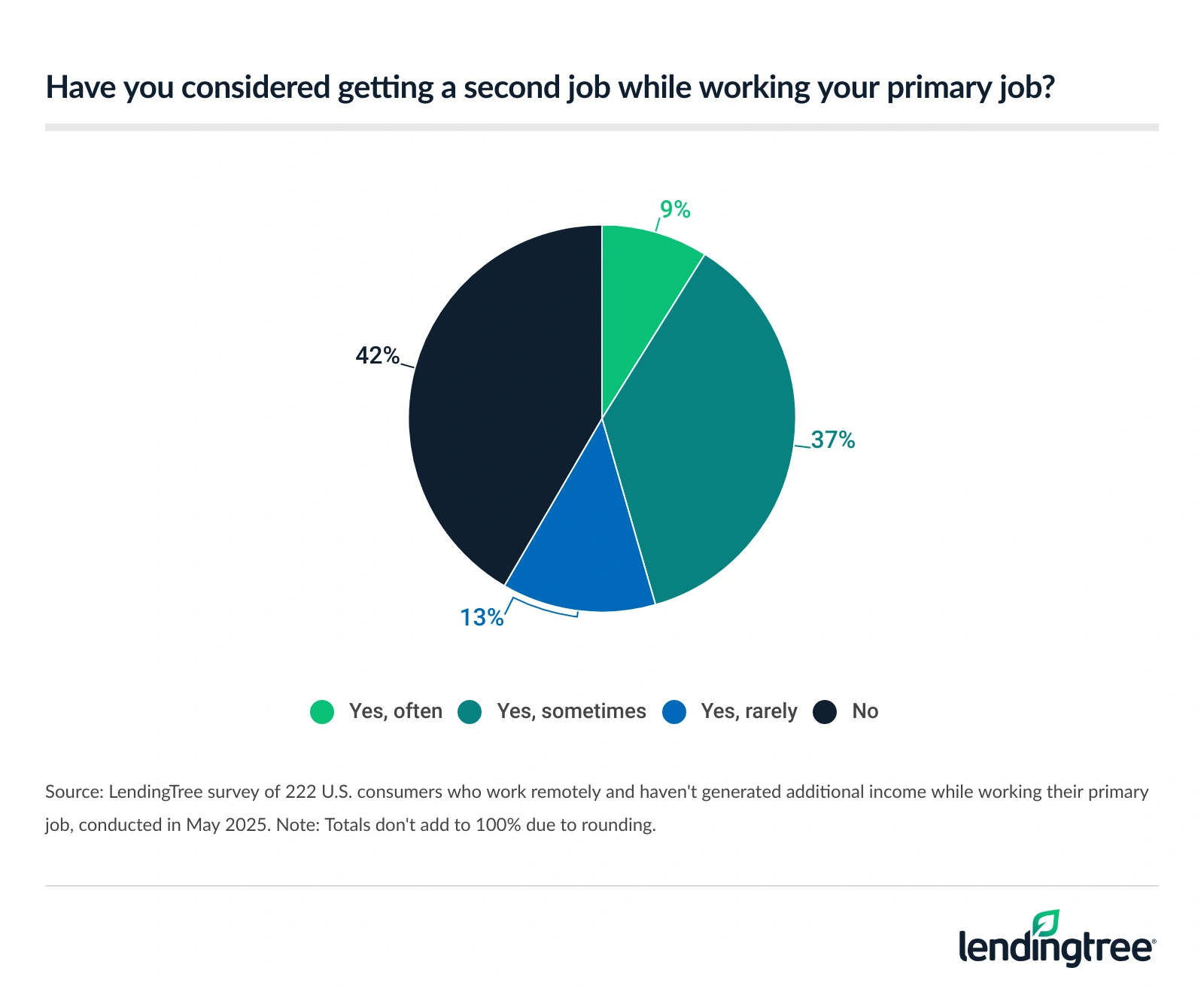
“It can be tempting to try to generate some extra income while working remotely, but it comes with real risk, too,” Schulz says.
“Splitting your focus that way can make you less productive. That’s dangerous any time, but especially in a time of significant economic uncertainty in which many companies are already looking for ways to get leaner and more efficient. The last thing you should do is keep secrets from your employer.”
Remote workers balance child care, household chores
Given the unique challenges remote work poses, it’s not surprising that most work-from-home employees juggle family and personal responsibilities while working.
Among remote workers with children younger than 18, 74% report caring for them while working at least some of the time — 39% say they always care for children when on the clock. Also, 69% of remote workers admit to doing household chores during working hours.
Despite taking on household responsibilities — or perhaps because of it — most remote workers (52%) report working longer hours than their employer expects. In comparison, 18% say they work fewer hours.
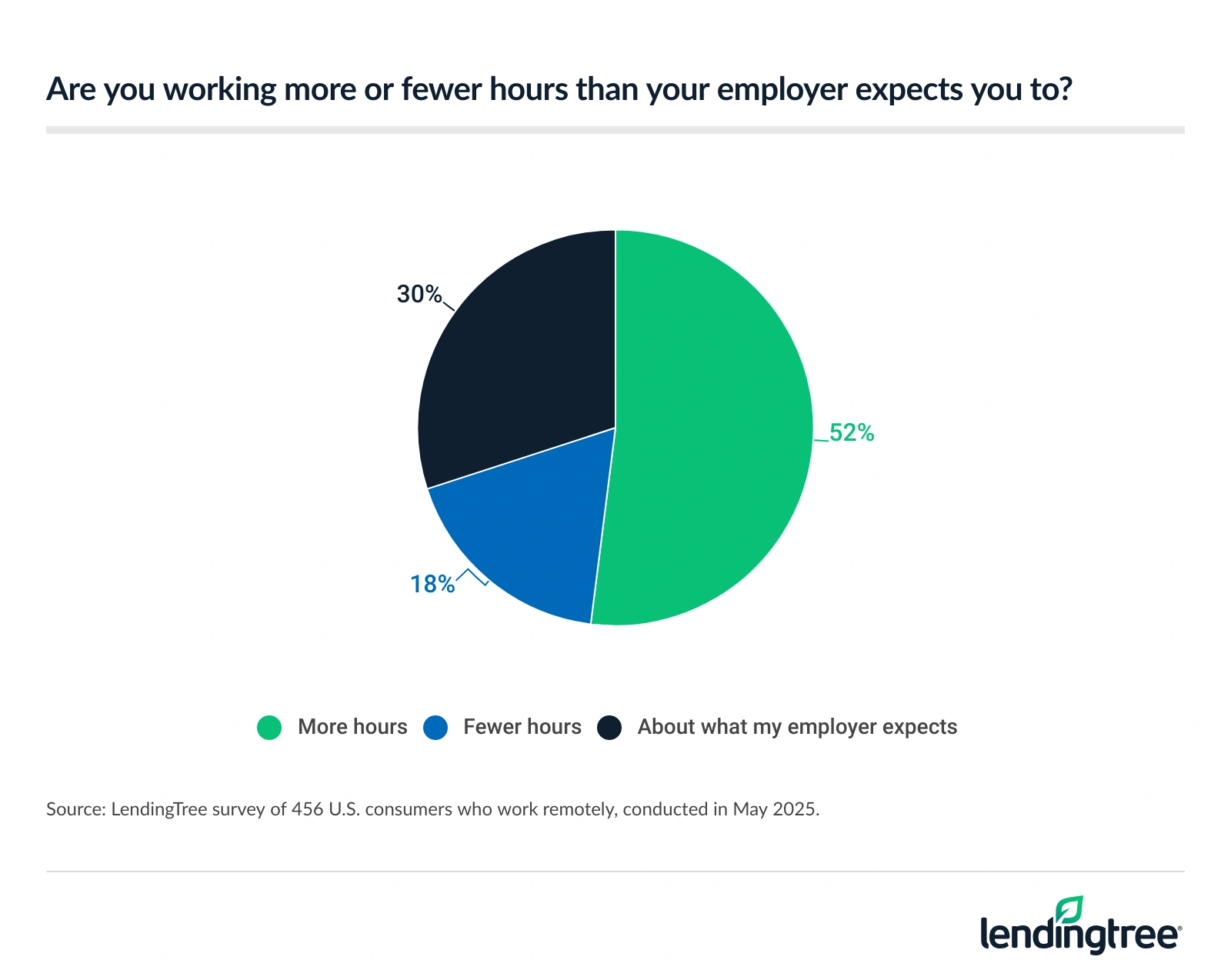
The most common workday length among remote workers is five to six hours. However, 51% of remote workers are on the clock for seven hours or more a day.
Number of hours remote workers estimate they work daily
- 0-1: 2%
- 2-4: 16%
- 5-6: 32%
- 7-8: 28%
- 9-10: 16%
- More than 10: 6%
Remote work a game-changer in daily lives of many
When asked about the biggest benefits of remote work, 50% of remote workers cite a better work-life balance. Not surprisingly, 90% say remote employment has improved their work-life balance. Other top benefits remote workers report include a flexible schedule (49%) and a lack of commute (44%).
Remote work also yields potentially unexpected advantages — 70% of remote workers report getting more sleep. And 66% say they feel more productive compared to working in an office. Notably, 71% of female remote workers say they’re more productive, while 63% of male remote workers say so.
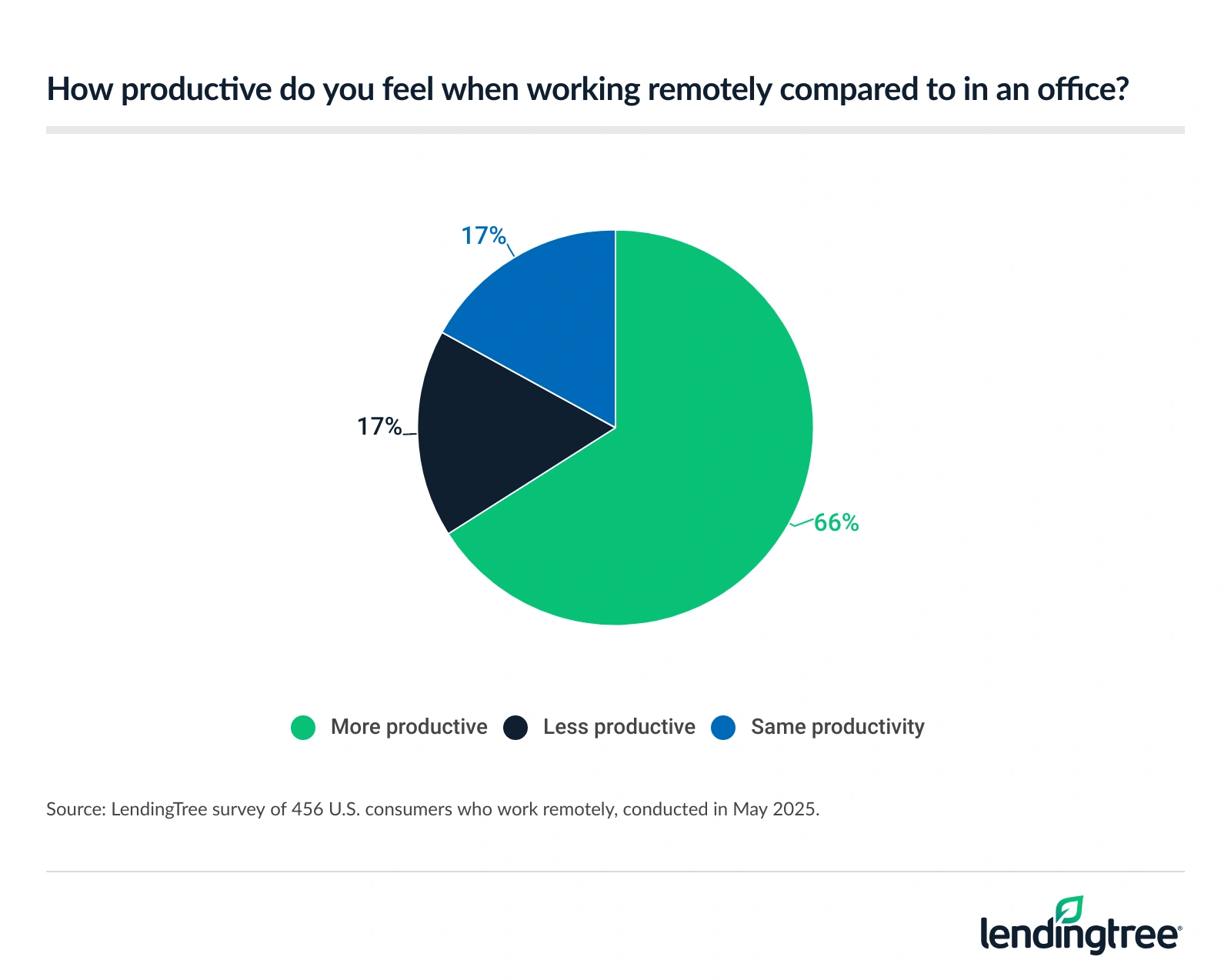
Despite the usage of productivity hacks among some work-from-home employees, 91% of remote workers say they feel their manager trusts them to be productive while working from home.
Many remote workers hope to never return to office
A sizable portion of remote workers want to maintain their work-from-home status permanently. In fact, 45% are opposed to returning to the office full time, and another 36% say it depends on the terms of the return.
Men are more resistant than women, with 49% saying they’re opposed to going back to the office full time, compared with 40% of women. More than half (54%) of remote workers with children under 18 are opposed to returning to the office.
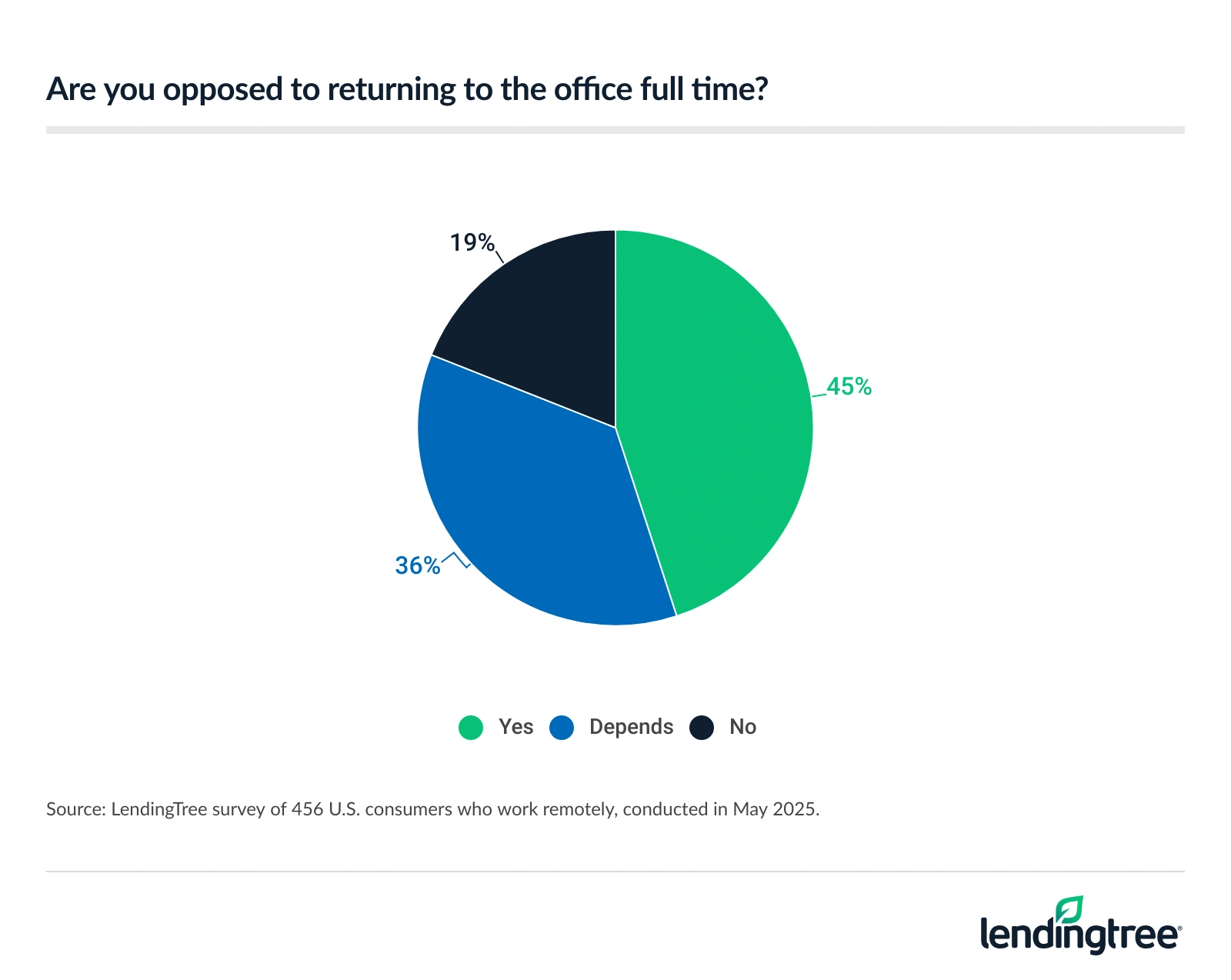
Many remote workers have leveraged their location independence — 42% have relocated after getting a remote-friendly job, with 45% of male remote workers making a move, compared with 38% of female remote workers. Half of remote workers with young children under 18 have relocated as a result of working from home.
3 ways working from home can save money
Besides enjoying better work-life balance and increased flexibility, remote workers also report significant financial benefits. Nearly 9 in 10 (89%) say they save money by working from home.
The top area of reported savings is transportation, with 72% of remote workers reducing expenses in that category. Other meaningful savings include food (55%) and clothing (46%).
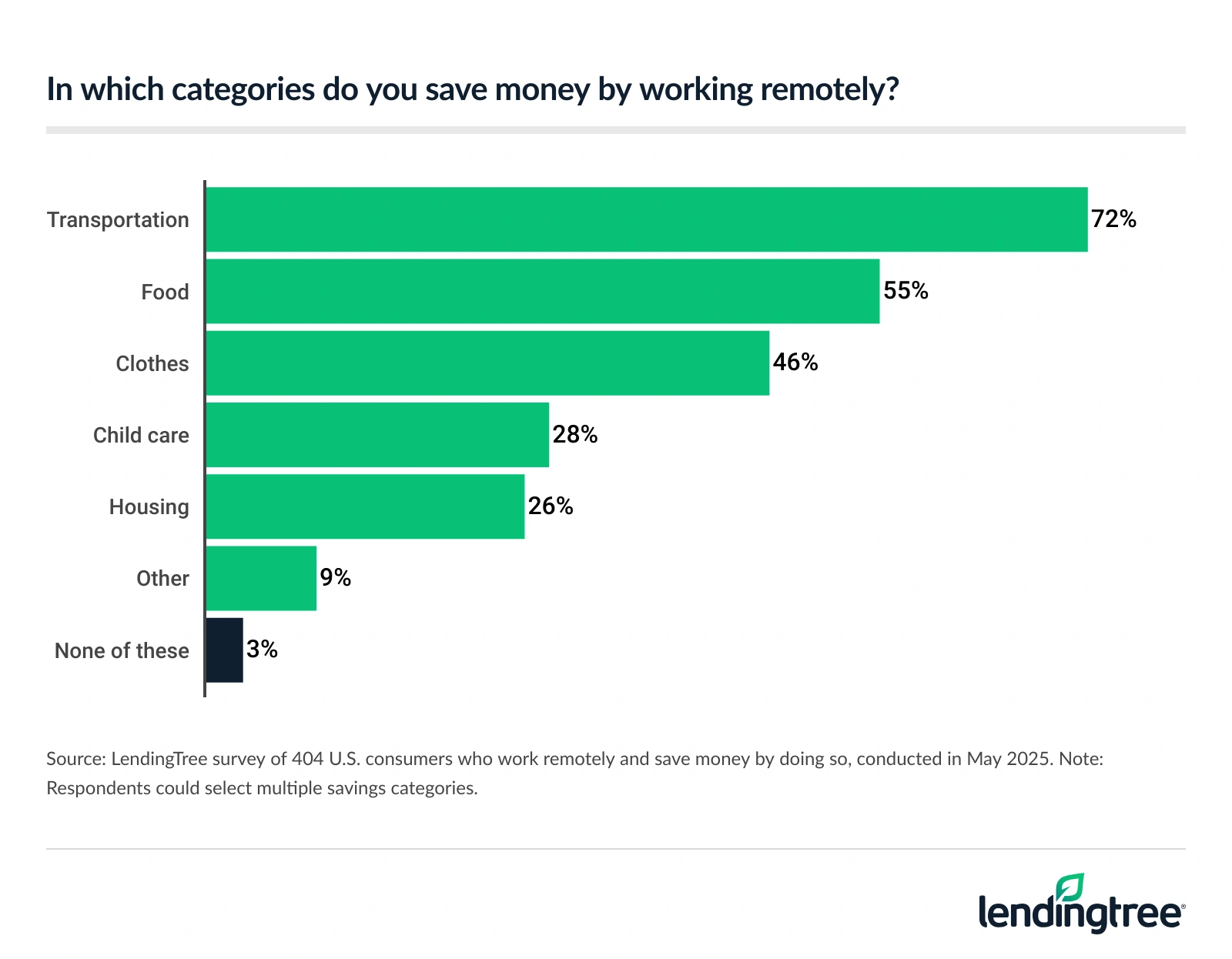
“Working at home can lead to huge savings,” says Schulz, author of “Ask Questions, Save Money, Make More: How to Take Control of Your Financial Life.” It can reduce spending on gas and food, create less wear and tear on your vehicles, save you money on clothing and reduce child care costs, he explains.
Here’s a closer look at where remote workers are saving — and how those savings can add up:
- Reduced commuting costs: American workers lose an average of $5,725 annually due to commuting. Working from home helps cut costs related to gas, car maintenance, insurance, public transportation and parking, putting significant cash back in employees’ pockets. Less commuting also saves time and reduces stress, which can lead to financial benefits.
- Fewer clothing purchases: Consumers spend an average of $2,041 per year on clothing and related services, according to recent U.S. Bureau of Labor Statistics data. If you don’t have to dress for the office every day, you can reduce this cost drastically, Schulz says. In addition to buying fewer clothes, remote workers save on laundry, dry cleaning and clothing or shoe repairs.
- Lower food expenses: Annual food spending outside the home costs Americans $3,933 a year. While not all of this is work-related, skipping office lunches, coffee runs and after-work get-togethers reduces that total considerably. Remote workers also avoid impulse food purchases and convenience meals often bought after a long day in the office.
Working from home can lower expenses in other areas, such as child care, pet care and housing, as some workers may relocate to more affordable locations. Collectively, these savings can increase disposable income and free up money for saving, investing or debt repayment.
Potential costs of remote work
While remote work offers clear financial advantages, it can also introduce new expenses. “You may spend more on some things when working from home,” Schulz says. For instance:
- Higher utility bills from increased use of heating or air conditioning
- Upgraded internet service for video calls or heavy data use
- Home office equipment such as desks, chairs or monitors
Even with these expenses, many remote workers find the overall financial benefits outweigh the costs.
Methodology
LendingTree commissioned QuestionPro to conduct an online survey of 2,000 U.S. consumers ages 18 to 79 from May 1 to 6, 2025. The survey was administered using a nonprobability-based sample, and quotas were used to ensure the sample base represented the overall population. Researchers reviewed all responses for quality control.
Get debt consolidation loan offers from up to 5 lenders in minutes
Read more
82% of Full-Time Workers Who Asked for Pay Raise Got One Updated November 18, 2024 More than three-quarters of the full-time workers who asked for a raise told us they…Read more
57% of Workers Considering Looking for a New Job, With Only 51% Earning More Than a Year Ago Updated September 18, 2023 Inflation has risen sharply over the last three years — however, many Americans’ salaries haven’t,…Read more


